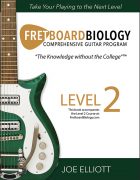LEVEL 2
Welcome to Level 2
Fretboard Biology Level 1 established a strong foundation in the following areas: Theory, Fretboard Logic, Technique, Rhythm Guitar, Improvisation, and Practice techniques. You may want to start at Level 1 regardless of your experience because Fretboard Biology has a unique approach to organizing Music Theory and the logic of the fretboard which is introduced in Level 1. If you’re more experienced you’ll move through these Units quickly but benefit greatly from learning the organizational system. You’ll also learn all the terminology we use through all the Levels and if you’re also a teacher, you can learn this method of teaching your students. If you’re less experienced, don’t rush through the material.
Theory
In the Theory Modules we learn about recognizing and building intervals and recognizing and building triads. Building on our knowledge of intervals and triads, we learn to harmonize the major and natural minor scales. This provides the foundation for harmonic analysis. We also learn the Blues scales.
Fretboard Logic
In the Fretboard Logic Modules we continue learning the organization system for the fretboard – the expanded CAGED system. As part of this we learn how all scales, arpeggios, and chords fit into what we’ll call the “Family Tree” of the fretboard. The Family Tree helps keep all the fretboard information we learn organized in an easily-understood system. We learn the rest of the major and minor pentatonic shells and the rest of the major and natural minor scales found within. We learn all five patterns of the Blues scale. We learn how all scales fit within the Family Tree. We also begin our study of arpeggios, starting with major and minor triad arpeggios as well as sus4 arpeggios. We learn how all arpeggios fit within the Family Tree, too. In our study of chords, we learn to mix barre and open-string chord voicings in progressions. We learn about the “super shape” system, which helps us understand three-string major and minor triad chord shapes all over the fretboard. We learn the practical triad chord shapes within each Octave Shape as well. We also learn all interval shapes found on the fretboard—from minor 2nds to the octave.
Technique
In the Technique Modules we work through alternate picking for the following subdivisions: 8th notes, 16th notes, 8th-note triplets, and 16th-note triplets. We also learn how to handle syncopation while following the alternate-picking rules.
Rhythm Notation
In Level 2, we’ll learn the basics of Rhythm Notation. In the Rhythm Notation Modules we’ll learn how to notate rhythms clearly. The guiding principle will be: “Music should look the way it sounds”.
Rhythm Guitar
In the Rhythm Guitar Modules we study two styles: Folk and Classic Rock.
Improvisation
In the Improvisation Modules we learn to solo in grooves that use the subdivisions explained in the Technique Modules. We continue to work on good storytelling through motif development and the use of the elements of contrast. The concept of chord tone soloing is introduced.
Practicing
If you have worked through Level 1, you’ve started to develop a practice routine. You may have also noticed that as the number of things to practice increases, it becomes more and more of a challenge to get in all into one session. In Level 2, we’ll discuss how to split up your task list into multiple routines so the work doesn’t overwhelm.


